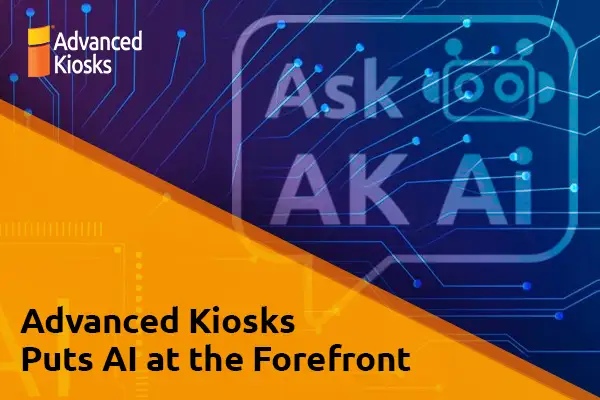Kiosk Software Development
Advanced Kiosks’ engineers are experts in kiosk integration.
We work with your third party software and hardware peripherals to create the best integrated kiosk solution for you. This lets you make the most of your new service kiosk while using the tools you already have.
- Third Party Software
- Databases and CRMs
- APIs
- Web Content
- Intranets
- Input or Output Devices
Third Party Software
Advanced Kiosks will work with your existing software so that your project will integrate with your kiosk. We understand that you may use third party software, such as accounting systems, databases, credit card processing, office applications, wayfinding, and much more. That is why our team has skilled, in-house software engineers to work with your providers’ APIs. This allows you to use your touch screen kiosk operating systems to their full potential.
Input / Output / External Devices
Advanced Kiosks’ hardware and software is made to support dozens of different external devices. This includes everything from thermal printers to thumbprint scanners and point of sale or bill payment components. We also offer a wide variety of standard kiosk development options that can take care of most custom user interface requests.
Every kiosk application project is unique and your kiosk integration needs may need to be specifically tailored. For this reason we have an experienced team of electrical and mechanical engineers as well as software developers to handle virtually any custom development solution requirements.
Common examples include: printers, scanners, cameras, touch pads, payment devices, proximity devices, and much more. Call today to discuss your specific kiosk application development needs.
Communications
If you want to serve up real-time video chat, voice over IP, proximity responses, and more to your interactive kiosk users, Advanced Kiosks will work with you to integrate the most efficient method of communication for your kiosk project customers and end users.
Application Program Interfaces (API)
We know that some projects will require our kiosk lockdown software to directly access and communicate with other applications. The Advanced Kiosks software development team can provide API integration services and will work with you from discovery to implementation on your custom kiosks systems project.
Custom IT Support Project
Developed in collaboration with a client in Cambridge, MA, the IT Support Pod combines privacy-enhancing hardware, intelligent automation, and real-time human support to solve IT issues anywhere – without the need for on-site staff.
Another example of how Advanced Kiosks can take your idea into production.
The Advanced Kiosks Solution: Strategic Two-Phase Approach
At Advanced Kiosks, we’ve structured our projects to directly address these industry failures. Our two-phase methodology ensures that every project starts with a solid foundation and proceeds only when success is virtually guaranteed.
The Software Development Crisis
The statistics are alarming. Across the software industry, projects consistently fail to meet expectations, exceed budgets, and miss deadlines. The root cause? Insufficient planning and poor requirements gathering.
%
of software projects exceed their initial budget
%
of project failures are due to poor requirements gathering
%
of software projects are canceled before completion
%
average budget overrun for large IT projects
The Advanced Kiosks Solution: Strategic Two-Phase Approach
At Advanced Kiosks, we've structured our projects to directly address these industry failures. Our two-phase methodology ensures that every project starts with a solid foundation and proceeds only when success is virtually guaranteed.
Traditional "Big Bang" Approach
- Rush into development without proper discovery
- Make assumptions about requirements
- Discover problems late in the process
- Face scope creep and budget overruns
- Risk total project failure
- No clear go/no-go decision point
- Client locked into full investment upfront
Advanced Kiosks Two-Phase Approach
- Thorough discovery and requirements validation
- Risk identification and mitigation planning
- Technical architecture validation
- Accurate scope and cost estimation
- Clear go/no-go decision point
- Controlled investment progression
- Virtually guaranteed success in Phase 2
How Our Two-Phase Structure Works
Go/No-Go Decision Point
Client makes informed decision based on complete Phase 1 deliverables
Discovery Phase
4-6 weeks
Requirements gathering, stakeholder workshops, technical architecture, risk assessment, and detailed specification development
Development Phase
3-6 months
Custom software development, integration, testing, deployment, and training based on validated requirements
Risk Mitigation Through Strategic Planning
From Risk to Certainty
Common Project Risks
- Unclear Requirements: Scope creep and missed expectations
- Technical Unknowns: Architecture decisions made too late
- Budget Overruns: Inaccurate initial estimates
- Timeline Delays: Unforeseen complexity and dependencies
Our Risk Mitigation
- Comprehensive Discovery: All requirements validated before development
- Technical Validation: Architecture proven before implementation
- Accurate Pricing: Fixed costs based on detailed specifications
- Realistic Timelines: Schedules based on validated complexity
The Value to Our Clients
Risk Mitigation
Phase 1 identifies and addresses potential issues before they become expensive problems, dramatically reducing project risk.
Cost Control
Accurate estimates based on validated requirements prevent budget overruns and unexpected costs during development.
Guaranteed Success
By the end of Phase 1, success in Phase 2 is virtually guaranteed because all unknowns have been resolved.
Faster Time to Market
Paradoxically, spending time in discovery actually accelerates overall delivery by eliminating rework and delays.
Informed Decisions
Clients make go/no-go decisions based on complete information, not assumptions or sales promises.
Technical Validation
Architecture and integration approaches are proven feasible before any major development investment.
Phase 1: Discovery & Specification
Our discovery phase is far more than requirements gathering—it's a comprehensive validation of your project's feasibility, approach, and success criteria.
- Typical Investment: $25,000 - $35,000 (160 hours maximum)
- Duration: 4-6 weeks
- Outcome: Complete project specification with go/no-go recommendation
Key Activities & Deliverables
Requirements Gathering
Stakeholder workshops, user interviews, and comprehensive requirement documentation
Technical Architecture
System design, integration planning, and technology stack validation
Risk Assessment
Comprehensive risk identification with mitigation strategies and contingency planning
Project Roadmap
Detailed timeline, resource allocation, and milestone planning for Phase 2
The Iceberg Effect: What You Don't See Will Sink Your Project
It's easy to create a beautiful user interface that looks like it does everything you want. But like an iceberg, 90% of software complexity is hidden beneath the surface—and that's where projects fail.
What Clients See
(10% of the work)
- Beautiful user interface
- Smooth interactions
- Working demo features
- Responsive design
What's Hidden Beneath
(90% of the complexity)
Infrastructure:
- Server architecture
- Load balancing
- Database design
- Network topology
Security:
- Access control systems
- Data encryption
- Authentication flows
- Vulnerability mitigation
Integration:
- API design & versioning
- Third-party connections
- Data synchronization
- Legacy system bridges
Edge Cases:
- Error handling scenarios
- Network failure recovery
- Concurrent user conflicts
- Invalid input validation
Operations:
- Automated backups
- Monitoring & alerting
- Performance optimization
- Disaster recovery
Maintenance:
- Update procedures
- Bug fix workflows
- Performance tuning
- Capacity planning
"Anyone can build a demo that works in perfect conditions. The real challenge is building software that works reliably in the real world, with real users, real problems, and real consequences."
— Advanced Kiosks Engineering Team
Why the "Hidden 90%" Destroys Projects
Without Proper Discovery:
- Edge cases discovered during development
- Security requirements emerge late
- Integration complexity underestimated
- Performance issues in production
- Maintenance costs explode
- Project timeline doubles or triples
With Phase 1 Discovery:
- All complexity mapped upfront
- Security architecture validated
- Integration challenges solved early
- Performance requirements defined
- Maintenance plan established
- Accurate timeline and costs
Real Example: The $200K Surprise
Client: "We just need users to upload files from their phones to print at kiosks. How hard can that be?"
The Hidden Reality:
- File format validation and conversion systems
- Secure temporary storage with auto-cleanup
- Multi-device session management
- Print queue optimization for concurrent users
- Payment processing integration with failure recovery
- Audit logging for compliance requirements
- Network interruption handling
- Malware scanning for uploaded files
- User data privacy compliance (CCPA, GDPR)
- Performance optimization for large files
Result: Our Phase 1 discovery identified $200,000 worth of "hidden" requirements that would have blindsided the project. By addressing them upfront, we delivered on time and on budget.
Aligned with Industry Best Practices
Our two-phase approach isn’t just our preference—it reflects proven industry best practices for complex software development projects.
“The discovery phase provides clear direction from its inception through requirements to follow through within areas of development. Such clarity, coupled with focus, can speed up software development stages and shorten time-to-market as it is often essential in competitive environments.” – Software Development Research
Why Leading Organizations Choose Phased Approaches:
- Risk Reduction: Problems identified early cost 5-10x less to fix than those found in production
- Quality Assurance: Each phase allows for feedback and improvement before proceeding
- Resource Optimization: Better planning leads to more efficient use of time and budget
- Stakeholder Alignment: Clear communication and shared understanding of project goals
- Regulatory Compliance: Essential for projects in healthcare, finance, and government sectors
Real-World Results
Our two-phase approach has delivered consistent success across diverse projects:
Alaska Courts
Complex file management system requiring government-grade security. Phase 1 identified critical integration challenges early, preventing what could have been a $200,000+ overrun.
Department of Interior
Remote reservation services deployment. Discovery phase revealed unique connectivity constraints that shaped the entire technical approach, ensuring successful rollout across multiple locations.
Hennepin County HHS
Large-scale kiosk network deployment. Phased approach allowed for iterative improvements and earned “Exceptional” CPARS rating from the U.S. Government.
Built on 25 Years of Industry Expertise
Advanced Kiosks doesn’t start from scratch. Our two-phase approach leverages over two decades of proven frameworks and software platforms, dramatically reducing development time and cost while ensuring reliability.
Your Project Deserves This Level of Care
Next Steps
Interested in our options? Ready to take the next step and have a discussion or get some prices? Call one of our tech experts or fill out the request form today!
QUESTIONS?
Call our solution specialists today to take your self-service project one step closer to success!
Request a Quote
Fill out this quick form and our tech specialists will get back to you with the next steps.






